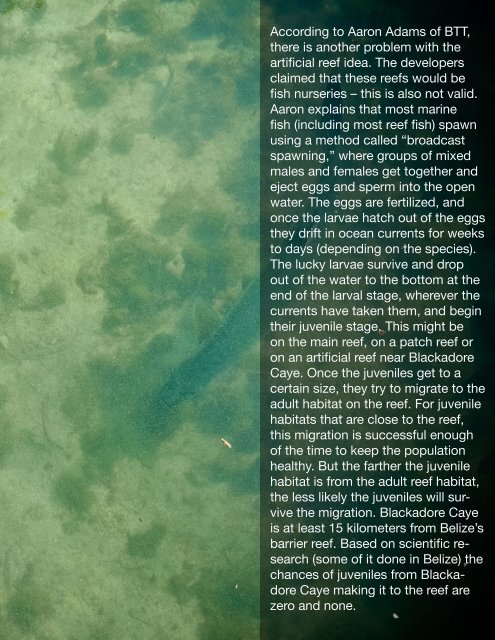scof21_
Create successful ePaper yourself
Turn your PDF publications into a flip-book with our unique Google optimized e-Paper software.
According to Aaron Adams of BTT,<br />
there is another problem with the<br />
artificial reef idea. The developers<br />
claimed that these reefs would be<br />
fish nurseries – this is also not valid.<br />
Aaron explains that most marine<br />
fish (including most reef fish) spawn<br />
using a method called “broadcast<br />
spawning,” where groups of mixed<br />
males and females get together and<br />
eject eggs and sperm into the open<br />
water. The eggs are fertilized, and<br />
once the larvae hatch out of the eggs<br />
they drift in ocean currents for weeks<br />
to days (depending on the species).<br />
The lucky larvae survive and drop<br />
out of the water to the bottom at the<br />
end of the larval stage, wherever the<br />
currents have taken them, and begin<br />
their juvenile stage. This might be<br />
on the main reef, on a patch reef or<br />
on an artificial reef near Blackadore<br />
Caye. Once the juveniles get to a<br />
certain size, they try to migrate to the<br />
adult habitat on the reef. For juvenile<br />
habitats that are close to the reef,<br />
this migration is successful enough<br />
of the time to keep the population<br />
healthy. But the farther the juvenile<br />
habitat is from the adult reef habitat,<br />
the less likely the juveniles will survive<br />
the migration. Blackadore Caye<br />
is at least 15 kilometers from Belize’s<br />
barrier reef. Based on scientific research<br />
(some of it done in Belize) the<br />
chances of juveniles from Blackadore<br />
Caye making it to the reef are<br />
zero and none.


